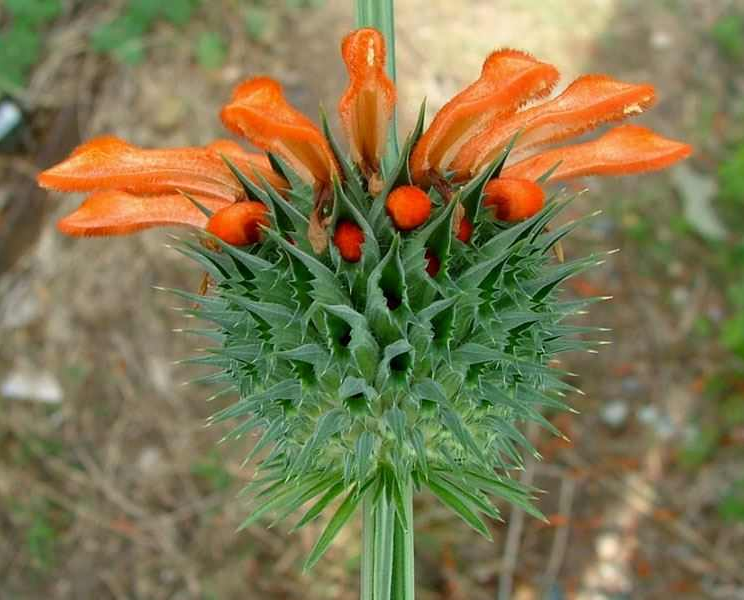
I never receive mail about Lion’s Ear, Leonotis leonurus. That’s odd because I receive excessive mail about Lactuca virosa — which is not psychotropic — yet none about Lion’s Ear which is mildly so.
A member of the greater mint family Lion’s Ear is native to tropical South Africa. It was being grown in Europe by the 1600’s. Some writers say it came to North America with early settlers. But, if that is true had to be with the Spanish as it is reported naturalized in Southern California but not elsewhere. (Curiously it grows around San Diego whereas L. virosa grows around San Francisco.) If all that is so then we have to ask which Lion’s Ear do we have in Florida — there are two — or do we have both? To explore that topic we need to sort out some language issues first.
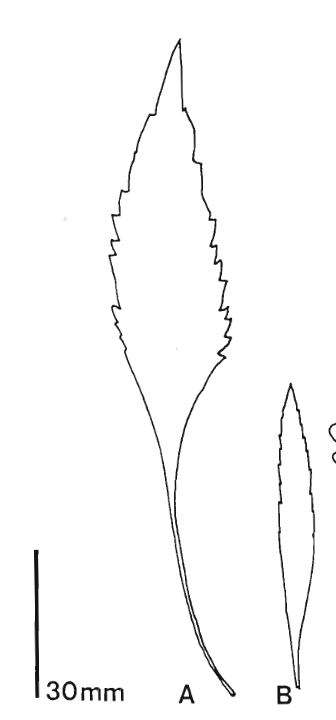
Lion’s Ear gives me a linguistic headache. In Dead Latin it’s Leonotis leonurus. Both words are corruptions of Greek: Leonotis mean’s Lion’s Ear; Leonurus means Lion’s Tail. That doesn’t help much except to explain why I sometimes call it Lion’s Ear and sometimes Lion’s Tail. If I’m not paying attention I also call it Lion’s Mane (which is definitely not correct.) Richard Wunderlin, the wunderkid of botanical taxonomy of Florida, says Leonotis nepetifolia not Leonotis leonurus is reported naturalized throughout Florida usually in “disturbed sites.” Leonotis leonurus can be cultivated here. Nepetifolia means “Lion’s Ear Catnip-like leaves.” The book Cornucopia II says of L. nepetifolia “Flowers are eaten in Tanzania. In Uganda they are cooked with green leafy vegetables.” So which do you have? A mind-altering cultivated L. leonurus or an escaped L. nepetifolia? While the flowering plants look similar L. nepetifolia has wide, long leaves (leaf A in the diagram above left.) L. leonurus has skinnier, shorter leaves (leaf B in the diagram.) As for being a psychotropic…
A 2015 study says Leonotis leonurus seems to be mildly pschoactive but they can’t quite explain why. The chemical that is supposed to do the trick, Leonurine, can’t be found in the plant. However “Research has proven the psychoactive effects of the crude extract of L. leonurus, but confirmation of the presence of psychoactive compounds, as well as isolation and characterization, is still required.” Sounds like a pitch for more research money. Others report both species contain marrubiin which is an analgesic and probably why they have been used in traditional medicine.
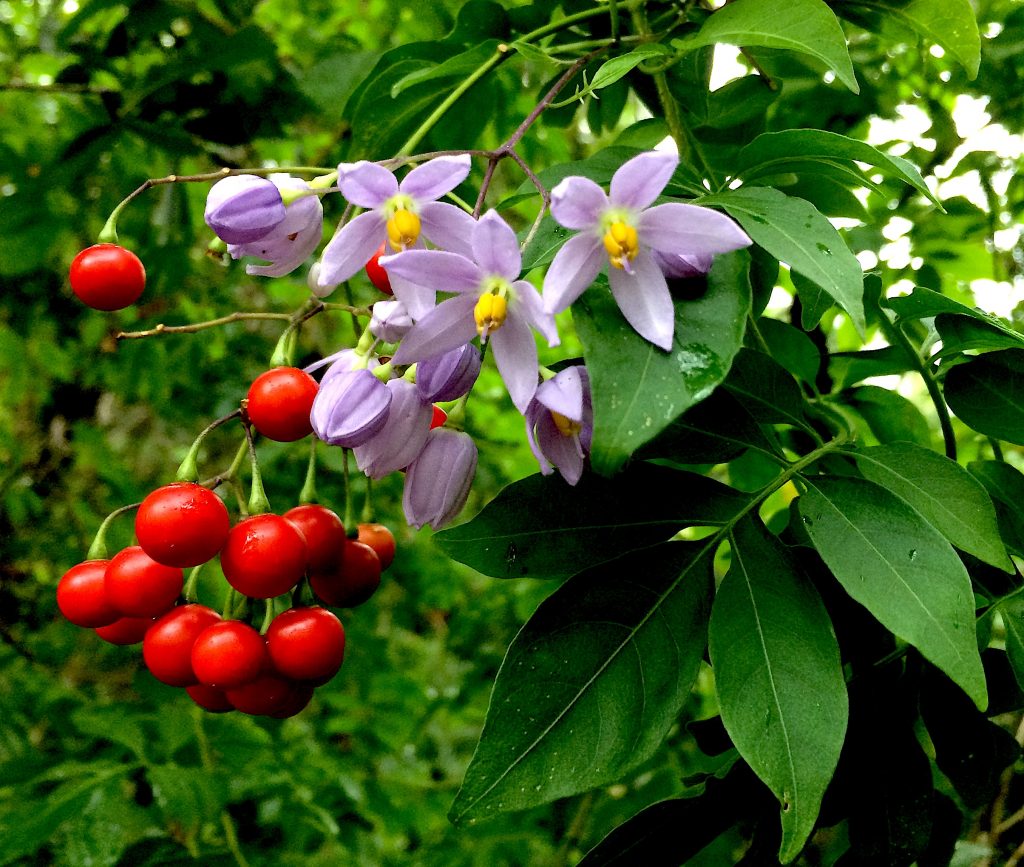
Just as there are two Lion’s Ears there are also two toxic Bittersweet Nightshades. In the same park where we saw the Lion’s Ear we also saw what appeared to be a Bittersweet Nightshade, Solanum dulcamara. This Nightshade is a wide-spread native of Europe and Asia. I first sighted it decades ago while hiking along bike trails near Washington D.C. It’s been used by herbalists since the Ancient Greeks. From an edible point of view the fruit is toxic to humans. Solanum dulcamara, however, is reported in only one northern county in Florida. So what did we see a little north of St. Petersburg, the real thing intentionally cultivated or a naturalized pretender to the botanical throne? As the leaves didn’t look right to me some research offered Solanum seaforthianum, which is the Brazilian Nightshade not the Bittersweet Nightshade. It’s fairly common in central and south Florida. This Nightsade is toxic like its genus-mate.

Regarding the name Solanum seaforthianum… “Solanum” has various interpretations such as to calm, to soothe, and to comfort. These are ancient references to the medicinal side of the species. As for seaforthianum… it, too, doesn’t help us much. The plant is named after Francis Humberton MacKenzie who was Lord Seaforth, 1754-1815. He was also a Baron and stone deaf from Scarlet Fever contracted at age 12 (exactly what happened to one of my grandfathers.) Seaforth was a general and plant collector, a fellow of the Royal Society, a fellow of the Linnean Society, and for a time a benevolent Governor of Barbados. Dulcamar, by the way, literally means “sweet bitter.” It is from Dead Latin’s “dulcis” meaning sweet and “amara” which means bitter. I have no idea why we reverse it in English to Bittersweet.
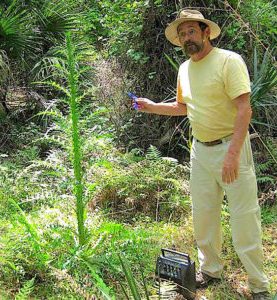
Last Saturday in our foraging class we got so drenched by rain I’m still wet. Sunday’s class at Ft. Meade was dryer thought the Peace River was above flood stage. Less rain is predicted this weekend. I have a class in Port Charlotte Saturday (along a broader section of the Peace River) and in east Orlando Sunday at Blanchard Park.
Saturday, August 24th,Bayshore Live Oak Park, Bayshore Drive. Port Charlotte.9 a.m. to noon. Meet at the parking lot at the intersection of Bayshore Road and Ganyard Street. 9 a.m. to noon.
Sunday, August 25th, Blanchard Park, 10501 Jay Blanchard Trail, Orlando, FL 32817. 9 a.m. to noon. Meet next to the tennis courts by the YMCA building.
Saturday August 31st,Wekiva State Park, 1800 Wekiwa Circle, Apopka, Florida 32712. 9 a.m. to noon. Arrive very early as there will be a lot of people wanting to go to the springs at 8 a.m. to swim. There is a park admission Fee: $6 per vehicle. Limit 8 people per vehicle, $4 for a single occupant vehicle, $2 pedestrians or bicyclists. Meet at the Sand Lake parking lot (road on left after entrance. Go to end of road.) Unlike city parks or the urban area, Wekiva Park is “wild” Florida. There are very few weeds of urbanization. The edibles are mostly native plants and far between. There is a lot of walking in this class. After class you can swim in the spring.
Sunday September 1st,George LeStrange Preserve, 4911 Ralls Road,Fort Pierce, FL,34981. 9 a.m. to noon. The preserve has no official bathroom or drinking water so take advantage of the various eateries and gas stations before arrival.
Saturday September 7th,329 N. Park Avenue, Winter Park. 9 a.m. to noon. Parking is free in the parking garage behind Panera’s. This is a class specializing in finding wild edibles in an urban setting.
Sunday September 8th,Ft. Desoto Park, 3500 Pinellas Bayway S. St. Petersburg Fl 33715. Meet by the bathrooms at the parking lot of the “bay” fishing pier (not the “gulf” fishing pier.) 9 a.m. to noon. There is a fee to get into the park. The fishing pier is about halfway along the SW/NE road along the southern end of the park.
Saturday, September 14th, Wickham Park: 2500 Parkway Drive, Melbourne, FL 32935-2335. 9 a.m. to noon.Meet at the “dog park” inside the park.
October 11-12-13, foraging classes at Putney Farm, Honea Path, South Carolina. Right now we are planning for classes at 9 and 1 on Saturday and 1 on Sunday.
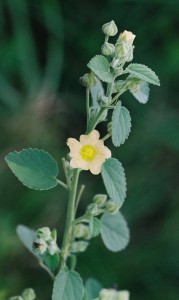
In keeping with our medicinal theme a group of plants called Sida should be mentioned. There are about 17 different species of Sida in the state. Most of them are rare or occasional. Their pinwheel blossom makes them fairly easy to recognize. The ones you are most likely to see are S. cordifolia and S. rhombifolia, both of which have Ephedrine in the leaves and roots. In fact. S. cordifolia is mentioned in Florida statutes. It can’t be made into a pill and given to kids under 18. This time of year I see S. cordifolia in pastures. It’s about two feet high now and spread out as if sprinkled all over the pasture. Clearly grazing cattle leave it alone. A tea made form the leaves is a “euphoric” pick-me-up which will also drive up your heart rate. It has other medicinal uses which are beyond my pay grade to discuss.
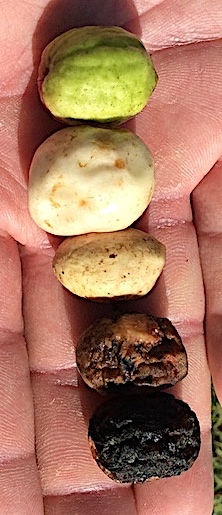
For many years I have eaten Gopher Apples and Tallow Plums. Both are native and they do share part of a season which is late spring to early summer more or less depending on the weather. What I have never done, because I find them at different times, is eat them together. A strapping, young, adult male reported to me that he ate about 20 Gopher Apples and 10 Tallow Plums at one sitting. They gave him temporary premature ventricular contractions which he verified by a heart monitor. The contractions went away in a short while. We don’t know which fruit might have caused said, or if it was a combination of them, the amount, a personal sensitivity or something else entirely. But, it is a report to keep in mind if you are about to eat a lot of Tallow Plums and Gopher Apples together, or perhaps even a lot of one species.
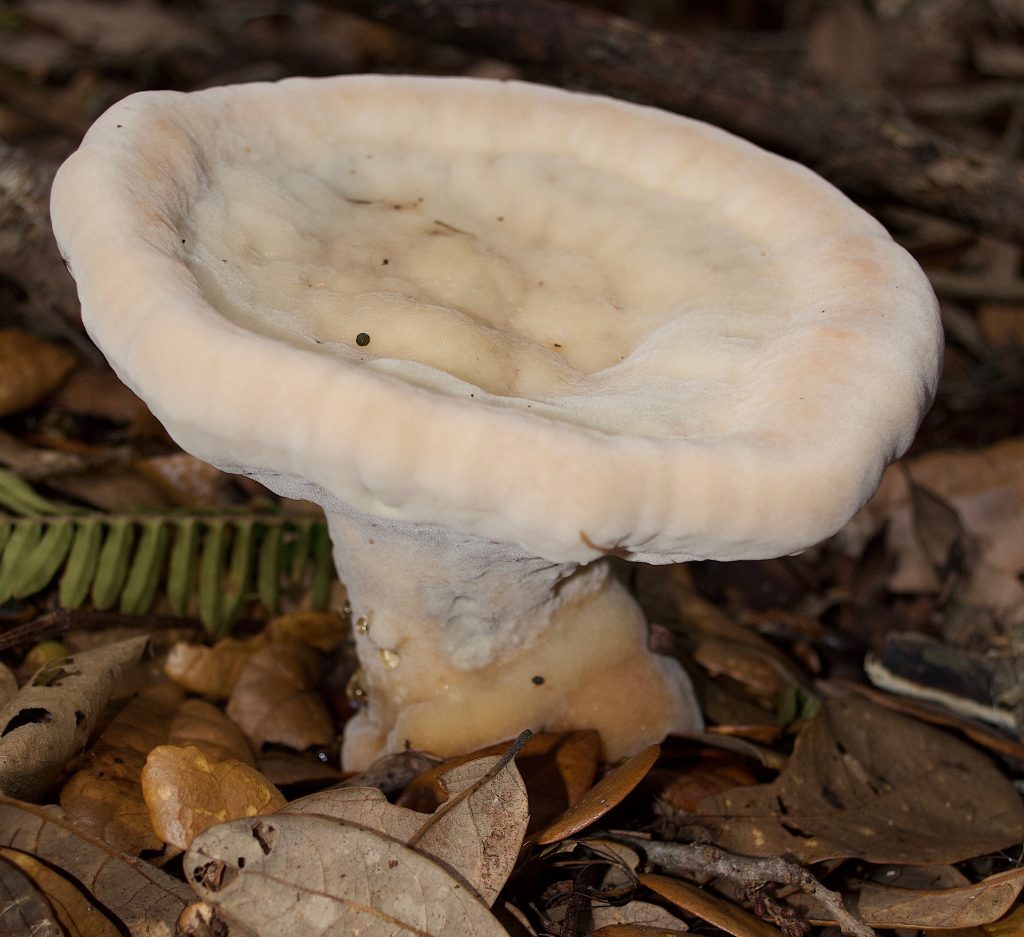
Yes it is edible but… we have perhaps three “Chicken of the Woods” fungi in Florida: Laetiperous sulphureus, L. gibsonii var. pallidus, and L. persicinus. The latter shares the same common name with another Laetiperous, the White Chicken of the Woods. The name Laetiperous (lay-TIP-er-ous) increases edible expectation because the other Laetiperous are enjoyable. Why mention this marginal mushroom? Laetiperous persicinus is edible, is being found now, and is relatively easy to identify. It’s a large mushroom — up to about eight inches across — usually growing at the base of oaks, and stains dark brown/black where ever you touch it especially anywhere it is light-colored. You can literally leave your fingerprints on it.
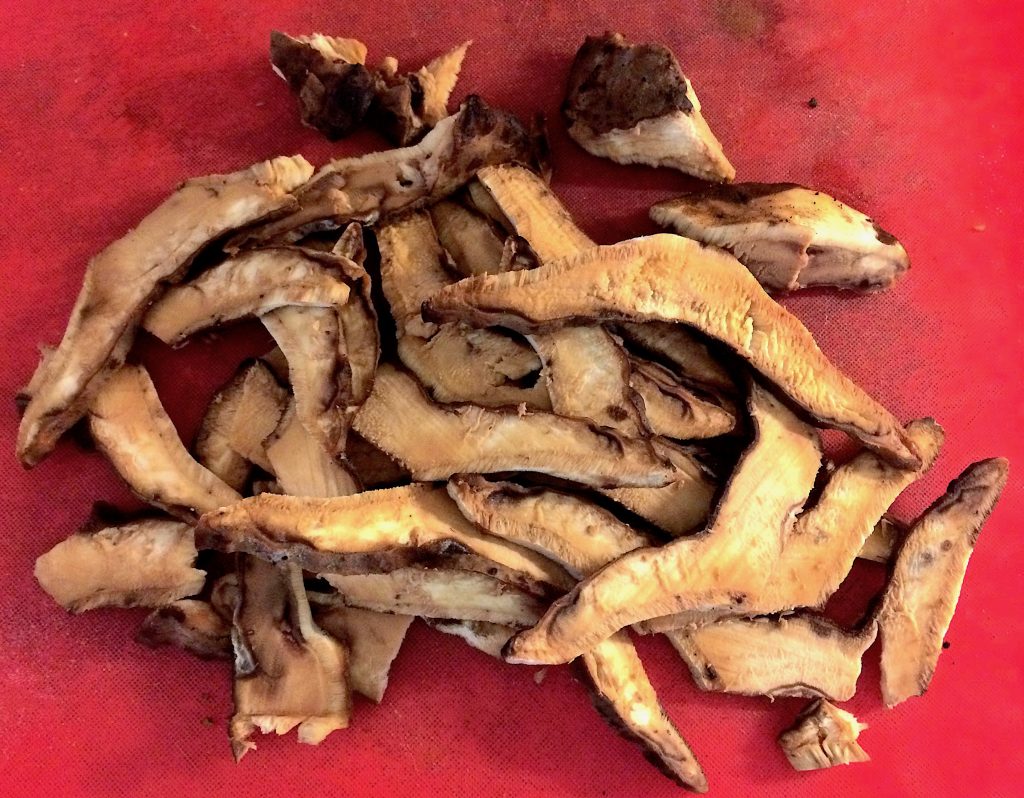
The mushrooms has a mild nearly non-existent flavor and a soft semi-crumbly texture. It doesn’t have a great mouth feel thus this “chicken” does better chopped up and put in a thick stew or soup. It needs chef experimentation. So far I have sliced and fried it. On it’s own the flavor is marginal and the texture non-resistant. One thing I tried recently worked reasonably well but I am sure we can do better. I fried strips in coconut oil with garlic powder and red pepper flakes. Then I added coconut-aminos until it was absorbed (Coconut Aminos is a soy sauce substitute.) After that I chilled them overnight to make sure the liquid was absorbed. In the morning I baked them, 350 degrees for 40 minutes. Better, even tasty. Next time I am going to skip the coconut-aminos and add beef stock flavor to see if I can get a semi-dry jerky-like flavor and texture.

Donations to upgrade EatTheWeeds.com and fund a book have gone well. Thank you to all who have contributed to either via the Go Fund Me link, the PayPal donation link or by writing to Green Deane POB 941793 Maitland FL, 32794. There are several in-the-way items that needs to be fixed.

All My Videos are available for free on You Tube. They do have ads on them so every time you watch a Green Deane video I get a quarter of one cent. Four views, one cent. Not exactly a large money-maker but it helps pays for this newsletter. If you want to see the videos without ads and some in slightly better quality you can order the DVD set. It is nine DVDs with 15 videos on each for a total of 135 videos. Many people want their own copy of the videos or they have a slow service and its easier to order then to watch them on-line. The DVDs make a good gift for that forager you know especially as spring is … springing. Individual DVDs can also be ordered or you can pick and choose. You can order them by clicking on the button on the top right hand side of this page (if your window is open wide enough.) Or you can go here.

Want to identify a plant? Perhaps you’re looking for a foraging reference? You might have a UFO, an Unidentified Flowering Object you want identified. On the Green Deane Forum we — including Green Deane and some 8,000 others from around the world — chat about foraging all year. And it’s not just about warm-weather plants or just North American flora. Many nations share common weeds so there’s a lot to talk about. There’s also more than weeds. The reference section has information for foraging around the world. There are also articles on food preservation, and forgotten skills from making bows to fermenting food.
This is weekly newsletter 369. You can sign up for this free newsletter by clicking on menu (or find in the command line) Newsletter Sign-up. These newsletters — like all my articles on the website — are written by me. There is no cut and paste… Every misspelling is mine and totally mine.


We have Leonotis nepetifolia in our Upstate SC chicken yard. Apparently the chickens don’t eat it, but their scratching spreads the seeds very well and they reseed every year.
Great read. It’s like you wrote the book on it or something. Your article has proven useful to me. Nice read.
HEY SPAM… I did write a book.